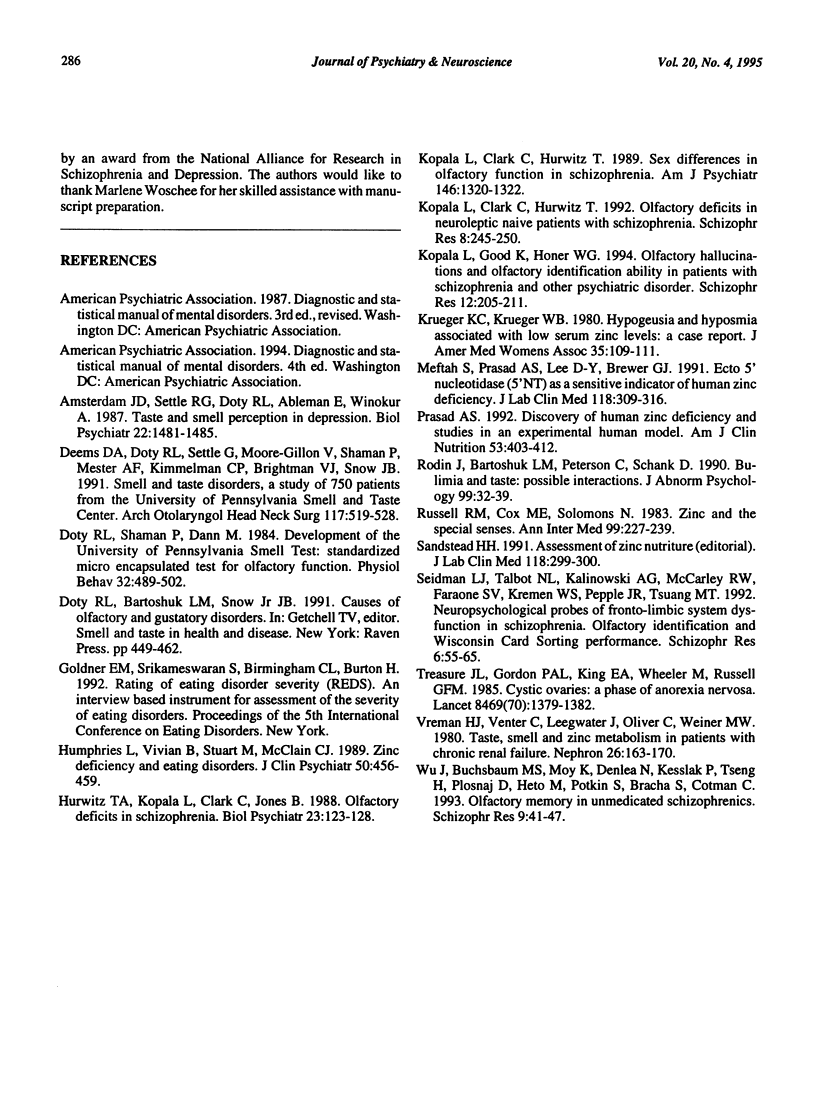Abstract
OBJECTIVE: The hypothesis tested was that patients with severe eating disorders would demonstrate olfactory identification deficits as a result of zinc deficiency or malnutrition. METHOD: The University of Pennsylvania Smell Identification Test (UPSIT) was administered to 27 hospitalized female patients with anorexia nervosa and 50 normal control female subjects. For a subgroup of patients, serum zinc levels and body mass indices were obtained at pre- and post-nutritional repletion phases. RESULTS: UPSIT scores for patients with eating disorders were equivalent to normal control subjects in spite of the fact that the patients were nutritionally compromised as determined by body mass index. Serum zinc levels were not significantly different at pre- and post-nutritional repletion. CONCLUSIONS: In contrast to patients with schizophrenia, patients with severe eating disorders have intact olfactory function. This finding suggests that transient metabolic or nutritional disturbances alone cannot account for previously reported olfactory deficits.
Full text
PDF



Selected References
These references are in PubMed. This may not be the complete list of references from this article.
- Amsterdam J. D., Settle R. G., Doty R. L., Abelman E., Winokur A. Taste and smell perception in depression. Biol Psychiatry. 1987 Dec;22(12):1481–1485. doi: 10.1016/0006-3223(87)90108-9. [DOI] [PubMed] [Google Scholar]
- Deems D. A., Doty R. L., Settle R. G., Moore-Gillon V., Shaman P., Mester A. F., Kimmelman C. P., Brightman V. J., Snow J. B., Jr Smell and taste disorders, a study of 750 patients from the University of Pennsylvania Smell and Taste Center. Arch Otolaryngol Head Neck Surg. 1991 May;117(5):519–528. doi: 10.1001/archotol.1991.01870170065015. [DOI] [PubMed] [Google Scholar]
- Doty R. L., Shaman P., Dann M. Development of the University of Pennsylvania Smell Identification Test: a standardized microencapsulated test of olfactory function. Physiol Behav. 1984 Mar;32(3):489–502. doi: 10.1016/0031-9384(84)90269-5. [DOI] [PubMed] [Google Scholar]
- Humphries L., Vivian B., Stuart M., McClain C. J. Zinc deficiency and eating disorders. J Clin Psychiatry. 1989 Dec;50(12):456–459. [PubMed] [Google Scholar]
- Hurwitz T., Kopala L., Clark C., Jones B. Olfactory deficits in schizophrenia. Biol Psychiatry. 1988 Jan 15;23(2):123–128. doi: 10.1016/0006-3223(88)90081-9. [DOI] [PubMed] [Google Scholar]
- Kopala L. C., Clark C., Hurwitz T. Olfactory deficits in neuroleptic naive patients with schizophrenia. Schizophr Res. 1993 Jan;8(3):245–250. doi: 10.1016/0920-9964(93)90022-b. [DOI] [PubMed] [Google Scholar]
- Kopala L. C., Good K. P., Honer W. G. Olfactory hallucinations and olfactory identification ability in patients with schizophrenia and other psychiatric disorders. Schizophr Res. 1994 Jun;12(3):205–211. doi: 10.1016/0920-9964(94)90030-2. [DOI] [PubMed] [Google Scholar]
- Kopala L., Clark C., Hurwitz T. A. Sex differences in olfactory function in schizophrenia. Am J Psychiatry. 1989 Oct;146(10):1320–1322. doi: 10.1176/ajp.146.10.1320. [DOI] [PubMed] [Google Scholar]
- Krueger K. C., Krueger W. B. Hypogeusia and hyposmia associated with low serum zinc levels, a case report. J Am Med Womens Assoc. 1980 Apr;35(4):109–111. [PubMed] [Google Scholar]
- Meftah S., Prasad A. S., Lee D. Y., Brewer G. J. Ecto 5' nucleotidase (5'NT) as a sensitive indicator of human zinc deficiency. J Lab Clin Med. 1991 Oct;118(4):309–316. [PubMed] [Google Scholar]
- Prasad A. S. Discovery of human zinc deficiency and studies in an experimental human model. Am J Clin Nutr. 1991 Feb;53(2):403–412. doi: 10.1093/ajcn/53.2.403. [DOI] [PubMed] [Google Scholar]
- Rodin J., Bartoshuk L., Peterson C., Schank D. Bulimia and taste: possible interactions. J Abnorm Psychol. 1990 Feb;99(1):32–39. doi: 10.1037//0021-843x.99.1.32. [DOI] [PubMed] [Google Scholar]
- Russell R. M., Cox M. E., Solomons N. Zinc and the special senses. Ann Intern Med. 1983 Aug;99(2):227–239. doi: 10.7326/0003-4819-99-2-227. [DOI] [PubMed] [Google Scholar]
- Sandstead H. H. Assessment of zinc nutriture. J Lab Clin Med. 1991 Oct;118(4):299–300. [PubMed] [Google Scholar]
- Seidman L. J., Talbot N. L., Kalinowski A. G., McCarley R. W., Faraone S. V., Kremen W. S., Pepple J. R., Tsuang M. T. Neuropsychological probes of fronto-limbic system dysfunction in schizophrenia. Olfactory identification and Wisconsin Card Sorting performance. Schizophr Res. 1991 Dec;6(1):55–65. doi: 10.1016/0920-9964(91)90021-i. [DOI] [PubMed] [Google Scholar]
- Treasure J. L., Gordon P. A., King E. A., Wheeler M., Russell G. F. Cystic ovaries: a phase of anorexia nervosa. Lancet. 1985 Dec 21;2(8469-70):1379–1382. doi: 10.1016/s0140-6736(85)92553-x. [DOI] [PubMed] [Google Scholar]
- Vreman H. J., Venter C., Leegwater J., Oliver C., Weiner M. W. Taste, smell and zinc metabolism in patients with chronic renal failure. Nephron. 1980;26(4):163–170. doi: 10.1159/000181974. [DOI] [PubMed] [Google Scholar]
- Wu J., Buchsbaum M. S., Moy K., Denlea N., Kesslak P., Tseng H., Plosnaj D., Hetu M., Potkin S., Bracha S. Olfactory memory in unmedicated schizophrenics. Schizophr Res. 1993 Mar;9(1):41–47. doi: 10.1016/0920-9964(93)90008-7. [DOI] [PubMed] [Google Scholar]


